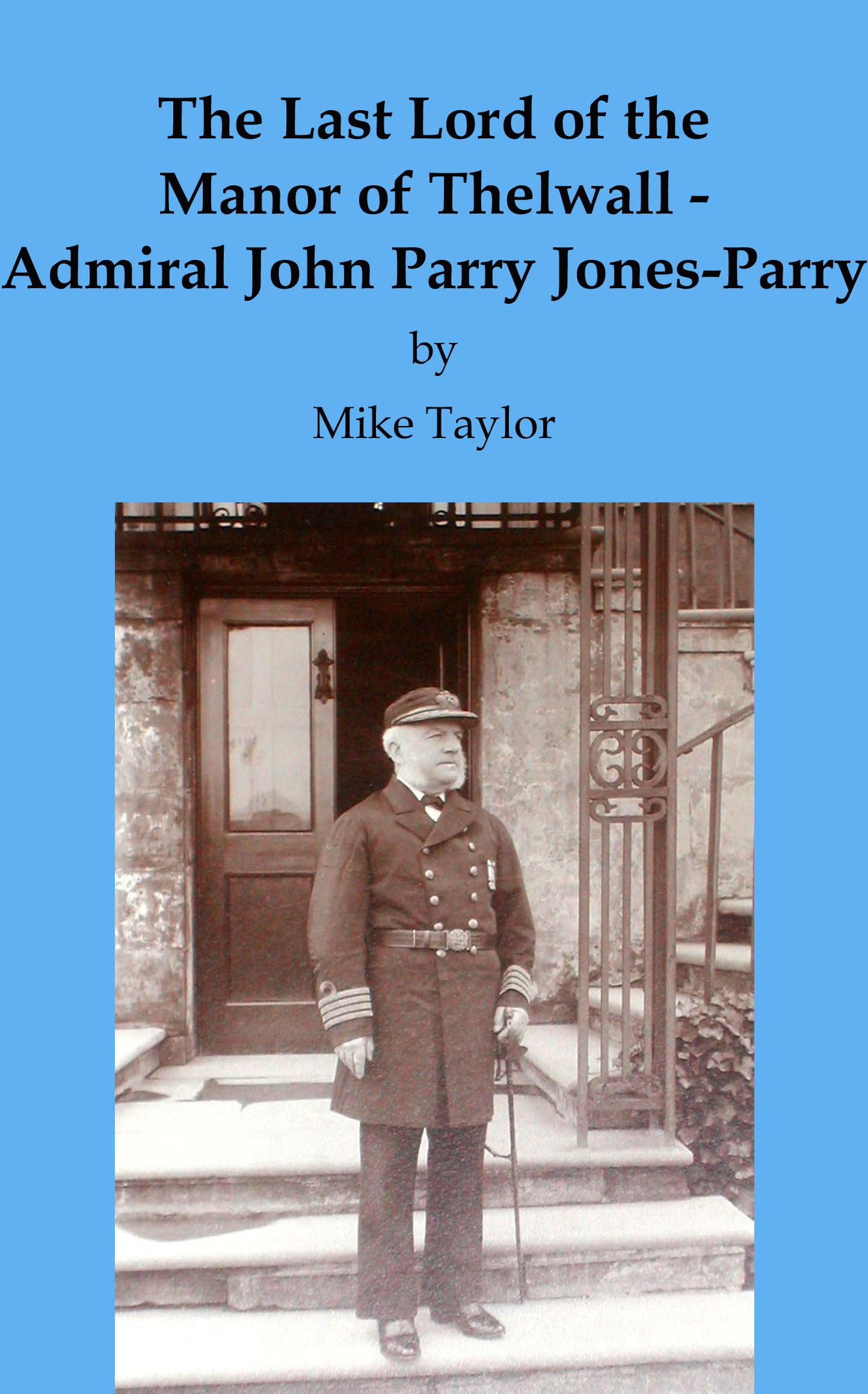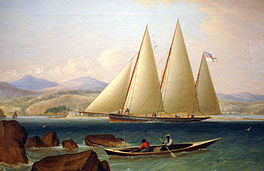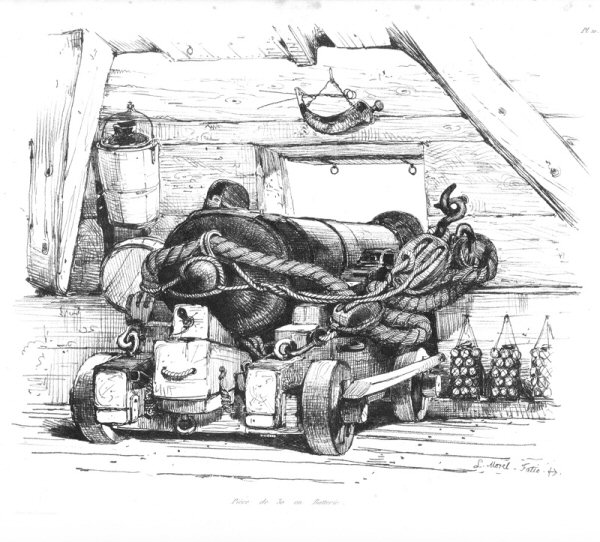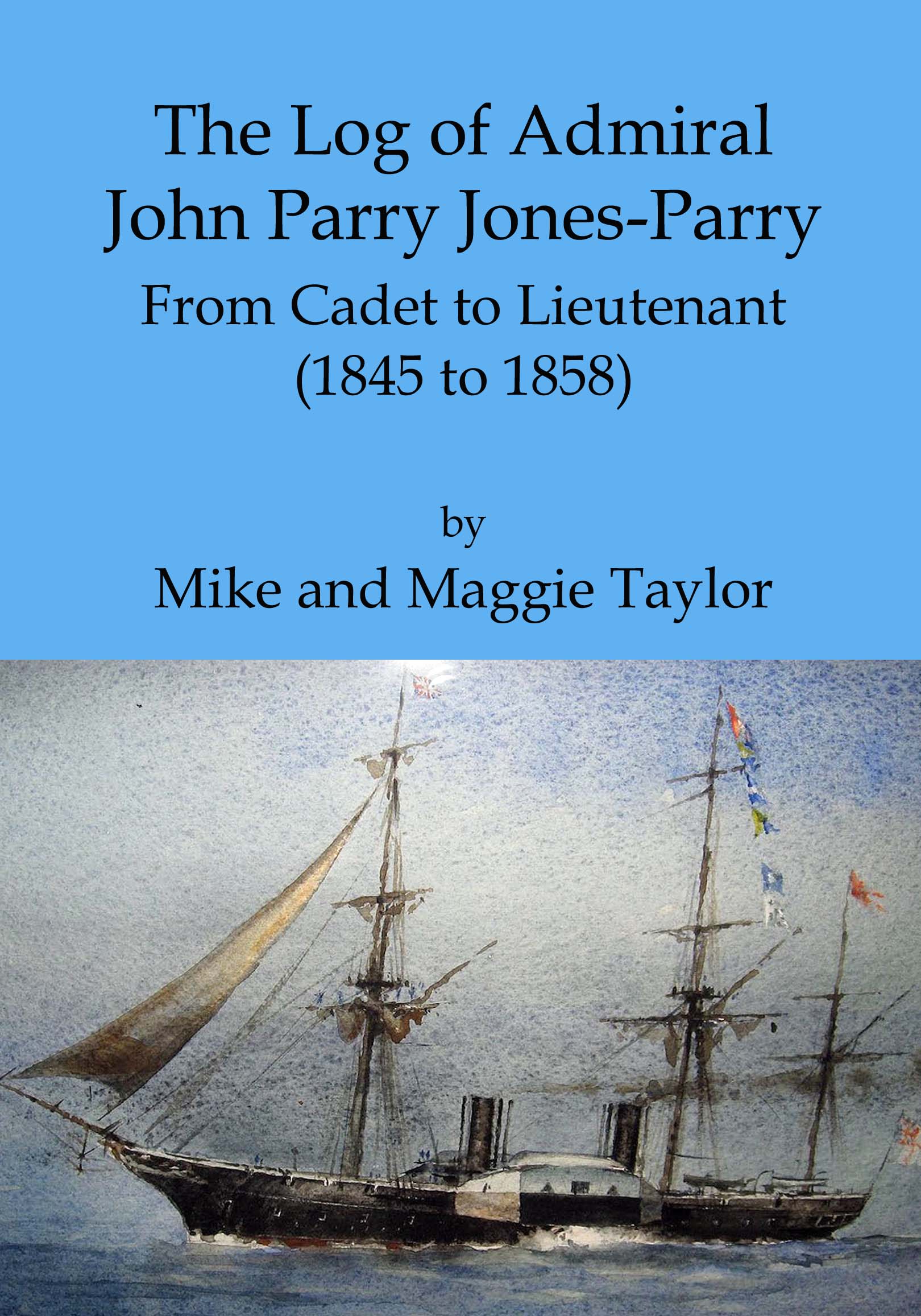20220417 20220413 CLHG Report Thelwall’s Last Lord of the Manor
Report Thelwall Lord April, 14th, 2022,
Going Out with a Bang!:
Thelwall's Last Lord of the Manor by speaker Mike Taylor.
On a fine evening on Thursday April 14th, our members and a few visitors listened to our speaker of the evening Mike Taylor and his wife Maggie give a very well prepared and illustrated talk on an “accidental” last Lord of the Manor of Thelwall, the Rear Admiral John Parry Jones-Parry (1829-1920).
The life and times of this man “JPJP”, John Parry Jones-Parry was described to us including his early hardships, diligent study, and advancement through the ranks to Captain, R.N. then his retirement and ultimate retired rank of Rear Admiral and became The lord of the Manor of Thelwall.

Admiral John Parry Jones-Parry on steps of Thelwall Manor, when a guest, before inheriting the Manor.
Illustration Image of JPJP.
Lord of the Manor.
What were the powers or duties of a “Lord of the Manor”.
These are well defined on the Thelwall Community Website from which this extract is taken:
http://thelwallcommunity.co.uk/past/lords-of-the-manor-of-thelwall/
'Lord of a Manor' was a job description, not a title. It carried the right and obligation to conduct manorial courts to control the occupants of the township. Manorial courts sorted out local squabbles over land, property maintenance, personal behaviour and so on. Since the Lord of the Manor probably owned the house and land that a person occupied, the courts' powers ranged from fines to eviction from the village. These local powers were eventually subsumed in the local magistrates courts.
The community website gives a list of the Lords of the Manor of Thelwall from the 1070s after the Norman Conquest until the death of JPJP.
Thelwall Hall aerial photo ex Thelwall History Group
Early childhood and thirst for learning.
Our speaker gave a description of a hard childhood and early life with bullying when at boarding school, but JPJP overcome these and developed a hard shell, then took himself off to the Royal Navy, enlisted and studying hard in his ‘spare time’; rose up and was eventually accepted for Midshipman and thus started to enter the office class. It was stated that as soon as he got his midshipman post he immediately started hard on his studies for lieutenant, and eventually was subject to an interview by three Admirals to gain his sub-lieutenancy, he became a mate (sub-lieutenant) on November 17, 1851. He also had a rumbustious side at parties. The research by Mike Taylor has uncovered that he and a colleague broke much valuable tableware in a display cabinet when they overturned it during a party, and then went away without saying what had happened.
JPJP was very much aware that to be promoted he needed to be noticed, so when his captain was invited to a social event where influential persons would be present, JPJP took a few days leave journeyed by train to the event and introduced himself to the influential persons and his captain, who had before that ‘not noticed’ the junior officer. JPJP was now ‘known’ to his captain.
JPJP even stated to what ship he wanted to be attached for his second post so was sent to his choice, one of the new steam powered paddle vessels then being introduced to the navy. Thus he gaining experience first in sail and then in powered ships, before his transfer to a gunnery school in June 1846 to take up his main specialisation. He looked after his own advancement with studing and careful cultivationof those who could help him advance.
Gunnery specialist.
As a commander and gunnery specialist he later organised the overland ‘haul’ of four powerful guns from his ship to support the land forces in the Crimea campaign. That would be a very different affair from operating these guns on board a vessel.
He spent some time on a sloop of war, a small support vessel, swift and with limited guns, compared with a ‘Man of War’ vessel in interception of slave ships after Britain ended slavery and took armed action against the countries (France, America, Netherlands and others still practising slavery and the slave trade). While our speaker noted that commission, and its problems, as JPJP’s ship was slower and not so modern as the specially designed slave ships,
A note extracted from a military website might help our reader’s understanding of that period.
The main effort to stop slavery came from Britain.
Stopping the slave trade.
In 1867 JPJP was transferred to the gun vessel Speedwell, which he commanded on the West Coast of Africa, re-visiting his earlier anti-slavery duties in a RN sloop. Note. Do distinguish between a single mast sailing sloop and a Royal Navy ‘Sloop-of War’ with 3 masts and up to 18 guns.

Image Sloop of War, ex Wikipeia Royal Navy 3 masted "Bermuda Sloop" entering a West Indies port JPG
Quote ex forces.net
When the British Government passed the Slave Trade Act in 1807, the task of enforcing it fell to the Royal Navy. The trade, which Britain had dominated for decades, now had to be stopped but it wasn’t going to be easy. Many countries were still involved in slavery, including Britain but the Royal Navy was expected to intercept their ships, with or without international co-operation.
In 1808 the West Africa Squadron was set up to patrol the coast. It was poorly equipped for the task and assigned just two ships, a 32-gun frigate HMS Solebay and HMS Derwent. More ships were added to the fleet over the next decade but it was still not enough to patrol more than three thousand miles of coastline. Working in West Africa was not easy for personnel due to the risk of tropical disease and violent encounters. Personnel were five times more likely to die there than sailing in British waters. In 1819 the Royal Navy captured a slaving port and created a naval station in West Africa. This was later renamed Freetown and became the capital of the first British colony in West Africa, in Sierra Leone. The squadron also used Ascension Island in the mid-Atlantic as a supply depot, before this was moved to Cape Town.
In response to Britain’s advances, the slavers started using faster ships and used drastic action to avoid capture.
The Royal Navy could only take a ship *if it was carrying people*, so slavers would throw their human cargo overboard to evade being caught.
Britain’s attempts at slavery suppression had a strong humanitarian interest but it was also tied in to a wider geo-political battle to expand the country’s sphere of influence. By the mid-19th century, the squadron had 25 vessels, many of them having been seized from slavers, and more than two thousand personnel involved. Between 1808 and 1860, the West Africa Squadron captured 1,600 slave ships and freed 150,000 Africans. Britain’s efforts to break up trade later spread across North Africa, the Middle-East and the Indian Ocean. Overall it took nearly 60 years to abolish the trade for good.
Unquote
Source: https://www.forces.net/services/tri-service/how-royal-navy-helped-stop-slave-trade
Refer also to another website for a history of this period.
https://www.bbc.co.uk/history/british/abolition/royal_navy_article_01.shtml
Inventor JPJP.
Due to his familiarity with gunnery and a more ‘helpful’ attitude to others, he invented two items to help the gunnery crew.
The non-recoil gun-carriage; which stopped the recoil killing and maiming sailors in its random fast backward recoil path;
and a mantle, to protect the crew.

Image: Cannon 36 ponder long cannon Antoine Morel Fatio JPG
The wedges aligned the cannon in the vertical both for action and stowage. It recoiled over the deck on the wee wheels.
The nets show canister shot, like cluster bombs today.
Inheritance to Thelwall.
JPJP was not a lineal descendant to the line of Thelwall lords of the Manor, but inherited it via his sister who had married a Warrington solicitor William Nicholson, who was left the manor by The Pickering family, who had held it for some centuries, and after William died his wife JPJP’s sister left the Manor to him, as the Nicholson sons saw it as a money losing estate, while JPJP and his wife had lived in the manor during the period when they were homeless after his retirement (with no Navy job-tied supplied house) courtesy of the Nicholsons who had much spare space.
Parties.
Our speaker noted that JPJP had run yearly parties for all the children in Thelwall, about 75 children per year, which was a non-specific charity, when most charitable functions were tied to a religious organisation or denomination and only for ‘their sect’.
Two photographs of the children at a party were shown, which illustrated the small number (about 75) of children among the total small Thelwall population at that time.
Royal Navy record.
Link to JPJP's obituary
https://pdavis.nl/ShowObit.php?id=1694
For copywright reasons this is not reproduced here.
Books.
Our speaker’s interest in Thelwall has over the years much aided by ‘lockdown’ and with the aid of his wife Maggie has enabled the publication of a few books and booklets on the subject of JPJP.
The speaker noted his thanks to an old lady of Thelwall who had given him much information and allowed him to copy photographs from her family’s collection.
These books are available from the books part of the Thelwall Community Website, and if persons want author signed copies, or the price of foreign postage; they should contact the Thelwall Community website at their email “This email address is being protected from spambots. You need JavaScript enabled to view it. ”.
This email is located via the Contact button on the top bar of the website.
Website: http://www.thelwallcommunity.co.uk/books/
Cover illustrations of books price £7.99 including postage within the UK.

The Log of Admiral John Parry Jones Parry Cadet to Lieutenant Cover JPEG GBP £7.99

The Last Lord of the Manor of Thelwall cover JPG GBP £7.99
Reading old style cursive handwriting.
Decryption of JPJP’s own handwriting of his logs, and arduous task undertaken by Mike Taylor has also led to the publication of JPJP’s own records.
We were shown an illustration of the complex cursive handwriting of JPJP from his handwritten logs.
The members were greatful they did not have to read them in original and decypher the meaning of some words.
Thanks.
The CLHG’s members and guests wish to express their thanks to Mike and Maggie Taylor for both an interesting evening and our being given a view of a time and lifestyle now long gone.
We were gratefull that Mike Taylor bravely spoke and entertained us while he had a bad throat.
We trust he recovered after our evening was over with speking duties done.
Links of interest.
https://www.warringtonguardian.co.uk/news/17628407.thelwall-local-history-group-launches/
https://en.wikipedia.org/wiki/Thelwall
https://www.olympiaauctions.com/sales/arms-armour/as300720/view-lot/164/
(Photo of JPJP’s swords as a Naval Officer, and the lightweight one as an Admiral.)
https://www.lymmheritageshop.co.uk/product-page/the-log-of-admiral-john-parry-jones-parry
Old Photographs, maps etc. of Thelwall are available at
https://www.francisfrith.com/thelwall
Facebook Thelwall Community post on book when published by Mike & Maggie Taylor.
https://www.facebook.com/ThelwallCommunity/posts/361856795710283

